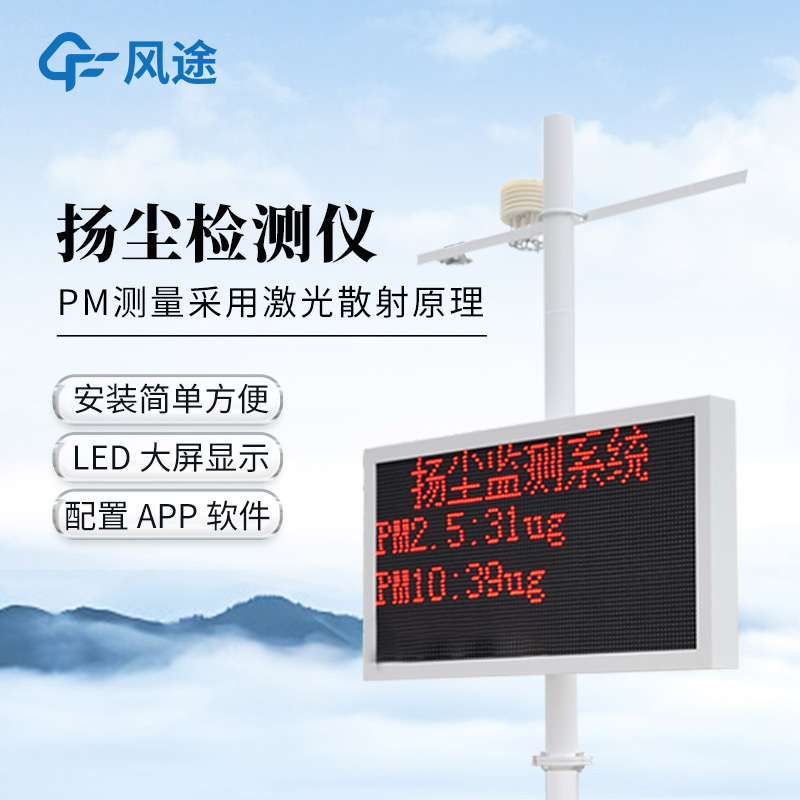Shandong Fengtu IOT Technology Co., Ltd
Sales Manager:Ms. Emily Wang
Cel,Whatsapp,Wechat:+86 15898932201
Email:info@fengtutec.com
Add:No. 155 Optoelectronic Industry Accelerator, Gaoxin District, Weifang, Shandong, China

Sales Manager:Ms. Emily Wang
Cel,Whatsapp,Wechat:+86 15898932201
Email:info@fengtutec.com
Add:No. 155 Optoelectronic Industry Accelerator, Gaoxin District, Weifang, Shandong, China
time:2025-06-11 09:31:50 source:Weather Station viewed:314 time
Dust detectors serve as vital tools for intelligent management of dust emission pollution, enabling real-time monitoring of dust concentration to provide data support for subsequent management measures.
A dust detector can collect real-time concentrations of particulate matters such as PM10 and PM2.5, along with meteorological parameters like temperature, humidity, wind speed, and wind direction. These data are transmitted wirelessly to a monitoring center or cloud platform, achieving 24-hour uninterrupted data collection. Take Fengtu's dust monitoring system as an example: the PM10/PM2.5 sensors in its diffused dust detector adopt the laser scattering principle, use a fan for power, and are equipped with an anti-insect net, effectively eliminating external interference and improving the accuracy of monitoring data.
By integrating data from dust detectors with technologies like cloud computing and big data, it is possible to achieve trend prediction and source tracing analysis of dust pollution. Through comparison and analysis of historical data, the system can forecast the occurrence time, location, and severity of dust pollution to prepare in advance for prevention and control. Meanwhile, combined with meteorological data and geographic information, it can accurately locate and trace the sources of dust pollution, providing a basis for targeted control measures.
Dust detectors can also intelligently interact with dust suppression equipment. When dust concentration exceeds the standard, the system not only sends alarm messages but also automatically activates nearby dust suppression devices such as sprinkler systems and fog cannons for automatic dust reduction, integrating monitoring and treatment to enhance the timeliness and effectiveness of dust pollution control.
Managers can remotely access the monitoring platform via terminals like computers and mobile phones to view real-time data, historical records, and alarm logs of dust detectors anytime, anywhere. This enables remote monitoring and management of dust pollution, allowing them to grasp dust emission status without being on-site, thus significantly improving management efficiency and reducing costs.
To ensure the accuracy and reliability of dust detectors, regular maintenance and calibration are necessary, including cleaning sensors, replacing filters, and inspecting power supplies and signal transmission lines. Additionally, according to actual usage and equipment manuals, periodic calibration is required to guarantee the accuracy and stability of monitoring data, providing reliable equipment support for the intelligent management of dust pollution.
Finally, integrating dust detector data into a unified environmental protection supervision platform or smart city management platform realizes information sharing and collaborative management with relevant departments such as environmental protection, housing construction, and urban management. This breaks down information silos, forms a joint force for dust pollution control, enhances the coordination efficiency and supervision effectiveness among departments, and collectively promotes the effective governance of dust pollution.

A weather station is a commonly used meteorological instrument that provides detailed meteorological data and combines it with specific application scenarios, industries and specific options for the various sensing hardware devices that make it up. This equipment enables the timely and accurate dete...
Every year, before the spring ploughing and during the autumn harvest, the agriculture department monitors the soil moisture level and advises farmers on suitable farming practices. This is because moisture is important for crop growth. Monitoring moisture can help farmers to time their irrigation,...
rainfall detection is a device designed to detect the presence and intensity of rainfall, which can detect changes in rainfall in real time, regardless of sunlight, dust, leaves, etc....
A portable visibility sensor is a device capable of measuring the brightness of the surrounding environment and the visibility of the atmosphere. It usually uses laser or infrared technology to provide visibility data quickly and accurately by measuring parameters such as light scattering and reflec...